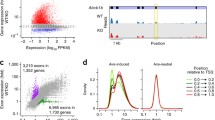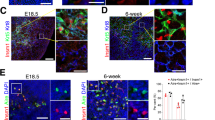Abstract
Gene expression of peripheral tissue antigens (PTAs) in stromal medullary thymic epithelial cells (mTECs) is a key process to the negative selection of autoreactive thymocytes. This phenomenon was termed “promiscuous gene expression” (PGE), which is partially controlled by the Aire gene. Nevertheless, reasons for the correlation of Aire and PTAs with the emergence of autoimmune diseases are largely unknown, though it may be a result of a chronological effect. Although the effect of Aire mutations in pathogenic autoimmunity is well know, it could not be a unique cause for autoimmunity. Independently of mutations, temporal deregulation of Aire expression may imbalance Aire-dependent PTAs and/or wide PGE. This deregulation may be an early warning sign for autoimmune diseases as it guarantees autoantigen representation in the thymus. To assess this hypothesis, we studied the expression levels of Aire, Aire-dependent (Ins2) and Aire-independent (Gad67 and Col2a1) PTAs using real-time-PCR of the thymic stromal cells of NOD mice during the development of autoimmune type 1 diabetes mellitus (DM-1). Wide PGE was studied by microarrays in which the PTA genes were identified through parallel CD80+ mTEC 3.10 cell line expression profiling. The results show that Aire gene was down-regulated in young pre-autoimmune (pre-diabetic) NOD mice. PGE and specific PTA genes were down-regulated in adult autoimmune diabetic animals. These findings represent evidence indicating that chronological deregulation of genes important to negative selection may be associated with the development of an autoimmune disease (DM-1) in mice.




Similar content being viewed by others
References
Klein L, Kyewski B (2000) Self-antigen presentation by thymic stromal cells: a subtle division of labor. Curr Opin Immunol 12(2):179–186. doi:10.1016/S0952-7915(99)00069-2
Derbinski J, Schulte A, Kyewski B, Klein L (2001) Promiscuous gene expression in medullary thymic epithelial cells mirrors the peripheral self. Nature Immunol 2(11):1032–1039. doi:10.1038/ni723
Kyewski B, Derbinski J (2004) Self-representation in the thymus: an extended view. Nat Rev Immunol 4(9):688–698. doi:10.1038/nri1436
Kyewski B, Klein L (2006) A central role for central tolerance. Annu Rev Immunol 24:571–606. doi:10.1146/annurev.immunol.23.021704.115601
Takahama Y (2006) Journey through the thymus: stromal guides for T-cell development and selection. Nat Rev Immunol 6(2):127–135. doi:10.1038/nri1781
Holländer GA (2007) Claudins provide a breath of fresh Aire. Nat Immunol 8(3):234–236. doi:10.1038/ni0307-234
Irla M, Hugues S, Gill J, Nitta T, Hikosaka Y, Williams IR, Hubert FX, Scott HS, Takahama Y, Holländer GA, Reith W (2008) Autoantigen-specific interactions with CD4+ thymocytes control mature medullary thymic epithelial cell cellularity. Immunity 29(3):451–463. doi:10.1016/j.immuni.2008.08.007
Villaseñor J, Besse W, Benoist C, Mathis D (2008) Ectopic expression of peripheral-tissue antigens in the thymic epithelium: probabilistic, monoallelic, misinitiated. Proc Natl Acad Sci USA 105(41):15854–15859. doi:10.1073/pnas.0808069105
Jolicoeur C, Hanahan D, Smith KM (1994) T-cell tolerance toward a transgenic beta-cell antigen and transcription of endogenous pancreatic genes in thymus. Proc Natl Acad Sci USA 91(14):6707–6711
Gotter J, Brors B, Hergenhahn M, Kyewski B (2004) Medullary epithelial cells of the human thymus express a highly diverse selection of tissue-specific genes colocalized in chromosomal clusters. J Exp Med 199(2):155–166. doi:10.1084/jem.20031677
Sousa-Cardoso R, Magalhães DA, Baião AM, Junta CM, Macedo C, Marques MM, Sakamoto-Hojo ET, Donadi EA, Passos GA (2006) Onset of promiscuous gene expression in murine fetal thymus organ culture. Immunology 119(3):369–375. doi:10.1111/j.1365-2567.2006.02441
Sospedra M, Ferrer-Francesch X, Domínguez O, Juan M, Foz-Sala M, Pujol-Borrell R (1998) Transcription of broad range of self-antigens in human thymus suggests a role for central mechanisms in tolerance toward peripheral antigens. J Immunol 161(11):5918–5929
Bruno R, Sabater L, Sospedra M, Ferrer-Francesch X, Escudero D, Martínez-Cáceres E, Pujol-Borrell R (2002) Multiple sclerosis candidate autoantigens except myelin oligodendrocyte glycoprotein are transcribed in the human thymus. Eur J Immunol 32(10):2737–2747. doi:10.1002/1521-4141(2002010)32:10<2737:AID-IMMU2737>3.0.CO;2-0
Bruno R, Sabater L, Tolosa E, Sospedra M, Ferrer-Francesch X, Coll J, Foz M, Melms A, Pujol-Borrell R (2004) Different patterns of nicotinic acetylcholine receptor subunit transcription in human thymus. J Neuroimmunol 149(1–2):147–159. doi:10.1016/j.jneuroim.2003.11.022
Derbinski J, Gäbler J, Brors B, Tierling S, Jonnakuty S, Hergenhahn M, Peltonen L, Walter J, Kyewski B (2005) Promiscuous gene expression in thymic epithelial cells is regulated at multiple levels. J Exp Med 202(1):33–45. doi:10.1084/jem.20050471
Gallegos A, Bevan MJ (2006) Central tolerance: good but imperfect. Immunol Rev 209:290–296. doi:10.1111/j.0105-2896.2006.00348.x
Kyewski B, Derbinski J, Gotter J, Klein L (2002) Promiscuous gene expression and central T-cell tolerance: more than meets the eye. Trends Immunol 23(7):364–371. doi:10.1016/S1471-4906(02)02248-2
Mathis D, Benoist C (2004) Back to central tolerance. Immunity 20(5):509–516. doi:10.1016/S1074-7613(04)00111-6
Magalhães DA, Silveira EL, Junta CM, Sandrin-Garcia P, Fachin AL, Donadi EA, Sakamoto-Hojo ET, Passos GA (2006) Promiscuous gene expression in the thymus: the root of central tolerance. Clin Dev Immunol 13(2–4):81–99. doi:10.1080/17402520600877091
Ramsey C, Winqvist O, Puhakka L, Halonen M, Moro A, Kämpe O, Eskelin P, Pelto-Huikko M, Peltonen L (2002) Aire deficient mice develop multiple features of APECED phenotype and show altered immune response. Hum Mol Genet 11(4):397–409
Nagamine K, Peterson P, Scott HS, Kudoh J, Minoshima S, Heino M, Krohn KJ, Lalioti MD, Mullis PE, Antonarakis SE, Kawasaki K, Asakawa S, Ito F, Shimizu N (1997) Positional cloning of the APECED gene. Nat Genet 17(4):393–398. doi:10.1038/ng1297-393
Aaltonen J, Björses P, Perheentupa J, Horelli-Kuitunen N, Palotie A, Peltonen L, Lee YS, Francis F, Henning S, Thiel C, Leharach H, Yaspo M (1997) An autoimmune disease, APECED, caused by mutations in a novel gene featuring two PHD-type zinc-finger domains. Nat Genet 17:399–403. doi:10.1038/ng1297-399
Su MA, Anderson MS (2004) Aire: an update. Curr Opin Immunol 16(6):746–752. doi:10.1016/j.coi.2004.09.009
Kont V, Laan M, Kisand K, Merits A, Scott HS, Peterson P (2008) Modulation of Aire regulates the expression of tissue-restricted antigens. Mol Immunol 45(1):25–33. doi:10.1016/j.molimm.2007.05.014
Heino M, Peterson P, Kudoh J, Nagamine K, Lagerstedt A, Ovod V, Ranki A, Rantala I, Nieminen M, Tuukkanen J, Scott HS, Antonarakis SE, Shimizu N, Krohn K (1999) Autoimmune regulator is expressed in the cells regulating immune tolerance in thymus medulla. Biochem Biophys Res Commun 257(3):821–825. doi:10.1006/bbrc.1999.0308
Heino M, Peterson P, Sillanpää N, Guérin S, Wu L, Anderson G, Scott HS, Antonarakis SE, Kudoh J, Shimizu N, Jenkinson EJ, Naquet P, Krohn KJ (2000) RNA and protein expression of the murine autoimmune regulator gene (Aire) in normal, RelB-deficient and in NOD mouse. Eur J Immunol 30(7):1884–1893. doi:10.1002/1521-4141(200007)30:7<1884:AID-IMMU1884>3.0.CO;2-P
Espanhol AR, Macedo C, Junta CM, Cardoso RS, Victorero G, Loriod B, Nguyen C, Jordan B, Passos GA (2003) Gene expression profiling during thymus ontogeny and its association with TCRVbeta8.1-Dbeta2.1 rearrangements of inbred mouse strains. Mol Cell Biochem 252(1–2):223–228. doi:10.1023/A:1025556510001
Chentoufi AA, Polychronakos C (2002) Insulin expression levels in the thymus modulate insulin-specific autoreactive T-cell tolerance: the mechanism by which the IDDM2 locus may predispose to diabetes. Diabetes 51(5):1383–1390
Pugliese A, Zeller M, Fernandez A Jr, Zalcberg LJ, Bartlett RJ, Ricordi C, Pietropaolo M, Eisenbarth GS, Bennett ST, Patel DD (1997) The insulin gene is transcribed in the human thymus and transcription levels correlated with allelic variation at the INS VNTR-IDDM2 susceptibility locus for type 1 diabetes. Nat Genet 15(3):293–297. doi:10.1038/ng0397-293
Vafiadis P, Bennett ST, Todd JA, Nadeau J, Grabs R, Goodyer CG, Wickramasinghe S, Colle E, Polychronakos C (1997) Insulin expression in human thymus is modulated by INS VNTR alleles at the IDDM2 locus. Nat Genet 15(3):289–992. doi:10.1038/ng0397-289
Taubert R, Schwendemann J, Kyewski B (2007) Highly variable expression of tissue-restricted self-antigens in human thymus: implications for self-tolerance and autoimmunity. Eur J Immunol 37(3):838–848. doi:10.1002/eji.200636962
Jiang W, Anderson MS, Bronson R, Mathis D, Benoist C (2005) Modifier loci condition autoimmunity provoked by Aire deficiency. J Exp Med 202(6):805–815. doi:10.1084/jem.20050693
Guerau-de-Arellano M, Martinic M, Benoist C, Mathis (2009) Neonatal tolerance revisited: a perinatal window for Aire control of autoimmunity. J Exp Med 206(6):1245–1252. doi:10.1084/jem.20090300
Gray DH, Chidgey AP, Boyd RL (2002) Analysis of thymic stromal cell populations using flow cytometry. J Immunol Methods 260(1–2):15–28. doi:10.1016/S0022-1759(01)00493-8
Nihei OK, Campos de Carvalho AC, Spray DC, Savino W, Alves LA (2003) A novel form of cellular communication among thymic epithelial cells: intercellular calcium wave propagation. Am J Physiol Cell Physiol 285(5):C1304–C1313. doi:10.1152/ajpcell.00568.2002
Macedo C, Evangelista AF, Magalhaes DA, Fornari TA, Linhares LL, Junta CM, Silva GL, Sakamoto-Hojo ET, Donadi EA, Savino W, Passos GA (2009) Evidence for a network transcriptional control of promiscuous gene expression in medullary thymic epithelial cells. Mol Immunol 46:3240–3244. doi:10.1016/j.molimm.2009.08.002
Hegde P, Qi R, Abernathy K, Gay C, Dharap S, Gaspard R, Hughes JE, Snesrud E, Lee N, Quackenbush J (2000) A concise guide to cDNA microarray analysis. Biotechniques 29(3):548–556
Tusher VG, Tibshirani R, Chu G (2001) Significance analysis of microarrays applied to the ionizing radiation response. Proc Natl Acad Sci USA 98(9):5116–5121. doi:10.1073/pnas.091062498
Eisen MB, Spellmam PT, Brown PO, Botstein D (1998) Cluster analysis and display of genome-wide expression patterns. Proc Natl Acad Sci USA 95:14863–14868
Su AI, Cooke MP, Ching KA, Hakak Y, Walker JR, Wiltshire T, Orth AP, Vega RG, Sapinoso LM, Moqrich A, Patapoutian A, Hampton GM, Schultz PG, Hogenesch JB (2002) Large-scale analysis of the human and mouse transcriptomes. Proc Natl Acad Sci USA 99(7):4465–4470. doi:10.1073/pnas.012025199
Atkinson MA, Leiter EH (1999) The NOD mouse model of type 1 diabetes: as good as it gets? Nat Med 5(6):601–604. doi:10.1038/9442
Anderson MS, Bluestone JA (2005) The NOD mouse: a model of immune dysregulation. Annu Rev Immunol 23:447–485. doi:10.1146/annurev.immunol.23.021704.115643
Castaño L, Eisenbarth GS (1990) Type-I diabetes: a chronic autoimmune disease of human, mouse, and rat. Annu Rev Immunol 8:647–679. doi:10.1146/annurev.iy.08.040190.003243
Serreze DV, Leiter EH (1994) Genetic and pathogenic basis of autoimmune diabetes in NOD mice. Curr Opin Immunol 6(6):900–906
Pitkänen J, Peterson P (2003) Autoimmune regulator: from loss of function to autoimmunity. Genes Immun 4(1):12–21. doi:10.1038/sj.gene.6363929
Acknowledgements
This study was funded by Fun dação de Amparo à Pesquisa do Estado de São Paulo (FAPESP), Brazil, Coordenação de Aperfeiçoamento de Pessoal de Nível Superior (CAPES), Ministry of Education of Brazil (MEC) and Conselho Nacional de Desenvolvimento Científico e Tecnológico (CNPq, Brazil). We thank Dr. Eduardo A. Donadi and Dr. Elza T. Sakamoto-Hojo and Dr. Zilá L. P. Simões from the University of São Paulo, Campus of Ribeirão Preto, Brazil by the laboratory facilities. The cDNA clones used to prepare microarrays were kindly ceded by Dr. Catherine Nguyen from the National Institute of Health and Medical Research (INSERM) Unit 928, Marseille, France.
Author information
Authors and Affiliations
Corresponding author
Additional information
Thaís A. Fornari and Paula B. Donate contributed equally to this study.
Electronic supplementary material
Below is the link to the electronic supplementary material.
Rights and permissions
About this article
Cite this article
Fornari, T.A., Donate, P.B., Macedo, C. et al. Age-related deregulation of Aire and peripheral tissue antigen genes in the thymic stroma of non-obese diabetic (NOD) mice is associated with autoimmune type 1 diabetes mellitus (DM-1). Mol Cell Biochem 342, 21–28 (2010). https://doi.org/10.1007/s11010-010-0464-z
Received:
Accepted:
Published:
Issue Date:
DOI: https://doi.org/10.1007/s11010-010-0464-z




